MBA: Leadership, Change, & External Environment of Coca-Cola
VerifiedAdded on 2023/05/31
|18
|6374
|204
Portfolio
AI Summary
This portfolio provides an in-depth analysis of global leadership and change management concepts, using Coca-Cola as a case study. It examines the external environment confronting Coca-Cola in the UK through PESTLE and Porter's Five Forces analyses, identifies the dominant organizational culture using Hofstede's cultural dimensions, and discusses the applicability of change theories like Lewin's change management model. The portfolio also reflects on personal leadership development, including the decision to pursue an MBA, previous work experiences, the learning process throughout the program, challenges faced, and support received from mentors. The assignment is an assessment of change theories and concepts in terms of their value to the organization.
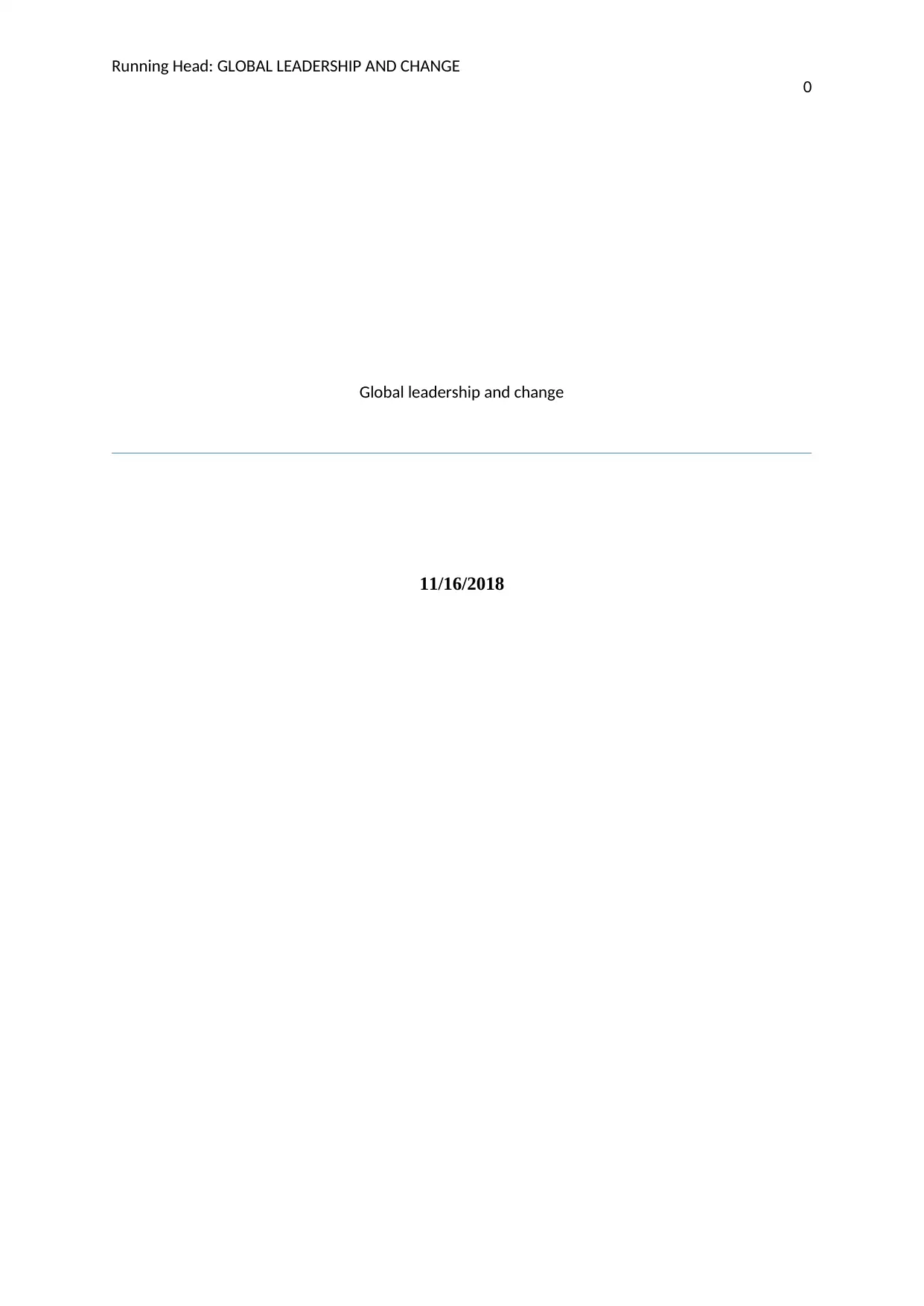
Running Head: GLOBAL LEADERSHIP AND CHANGE
0
Global leadership and change
11/16/2018
0
Global leadership and change
11/16/2018
Paraphrase This Document
Need a fresh take? Get an instant paraphrase of this document with our AI Paraphraser
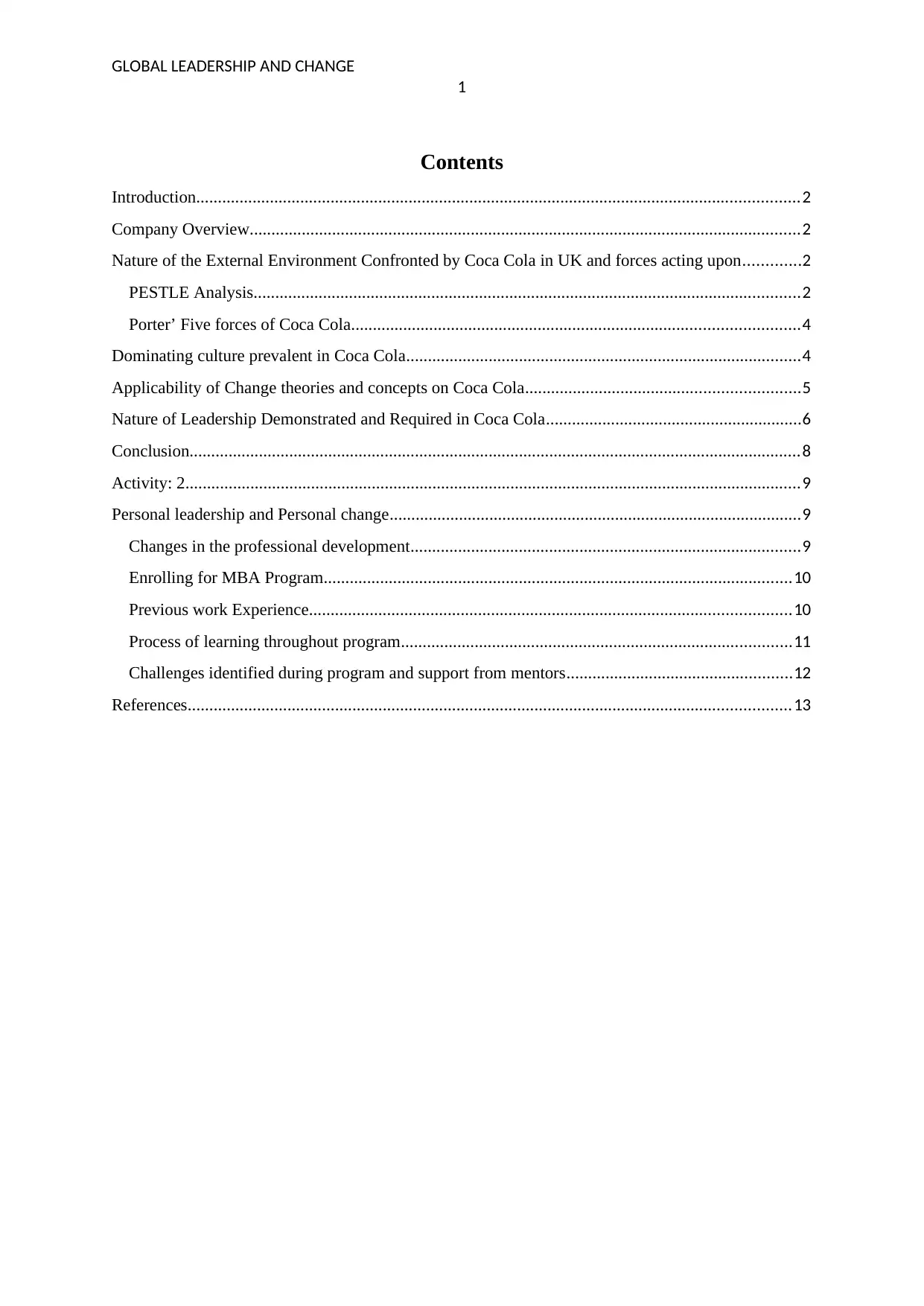
GLOBAL LEADERSHIP AND CHANGE
1
Contents
Introduction...........................................................................................................................................2
Company Overview...............................................................................................................................2
Nature of the External Environment Confronted by Coca Cola in UK and forces acting upon.............2
PESTLE Analysis..............................................................................................................................2
Porter’ Five forces of Coca Cola.......................................................................................................4
Dominating culture prevalent in Coca Cola...........................................................................................4
Applicability of Change theories and concepts on Coca Cola...............................................................5
Nature of Leadership Demonstrated and Required in Coca Cola...........................................................6
Conclusion.............................................................................................................................................8
Activity: 2..............................................................................................................................................9
Personal leadership and Personal change...............................................................................................9
Changes in the professional development..........................................................................................9
Enrolling for MBA Program............................................................................................................10
Previous work Experience...............................................................................................................10
Process of learning throughout program..........................................................................................11
Challenges identified during program and support from mentors....................................................12
References...........................................................................................................................................13
1
Contents
Introduction...........................................................................................................................................2
Company Overview...............................................................................................................................2
Nature of the External Environment Confronted by Coca Cola in UK and forces acting upon.............2
PESTLE Analysis..............................................................................................................................2
Porter’ Five forces of Coca Cola.......................................................................................................4
Dominating culture prevalent in Coca Cola...........................................................................................4
Applicability of Change theories and concepts on Coca Cola...............................................................5
Nature of Leadership Demonstrated and Required in Coca Cola...........................................................6
Conclusion.............................................................................................................................................8
Activity: 2..............................................................................................................................................9
Personal leadership and Personal change...............................................................................................9
Changes in the professional development..........................................................................................9
Enrolling for MBA Program............................................................................................................10
Previous work Experience...............................................................................................................10
Process of learning throughout program..........................................................................................11
Challenges identified during program and support from mentors....................................................12
References...........................................................................................................................................13
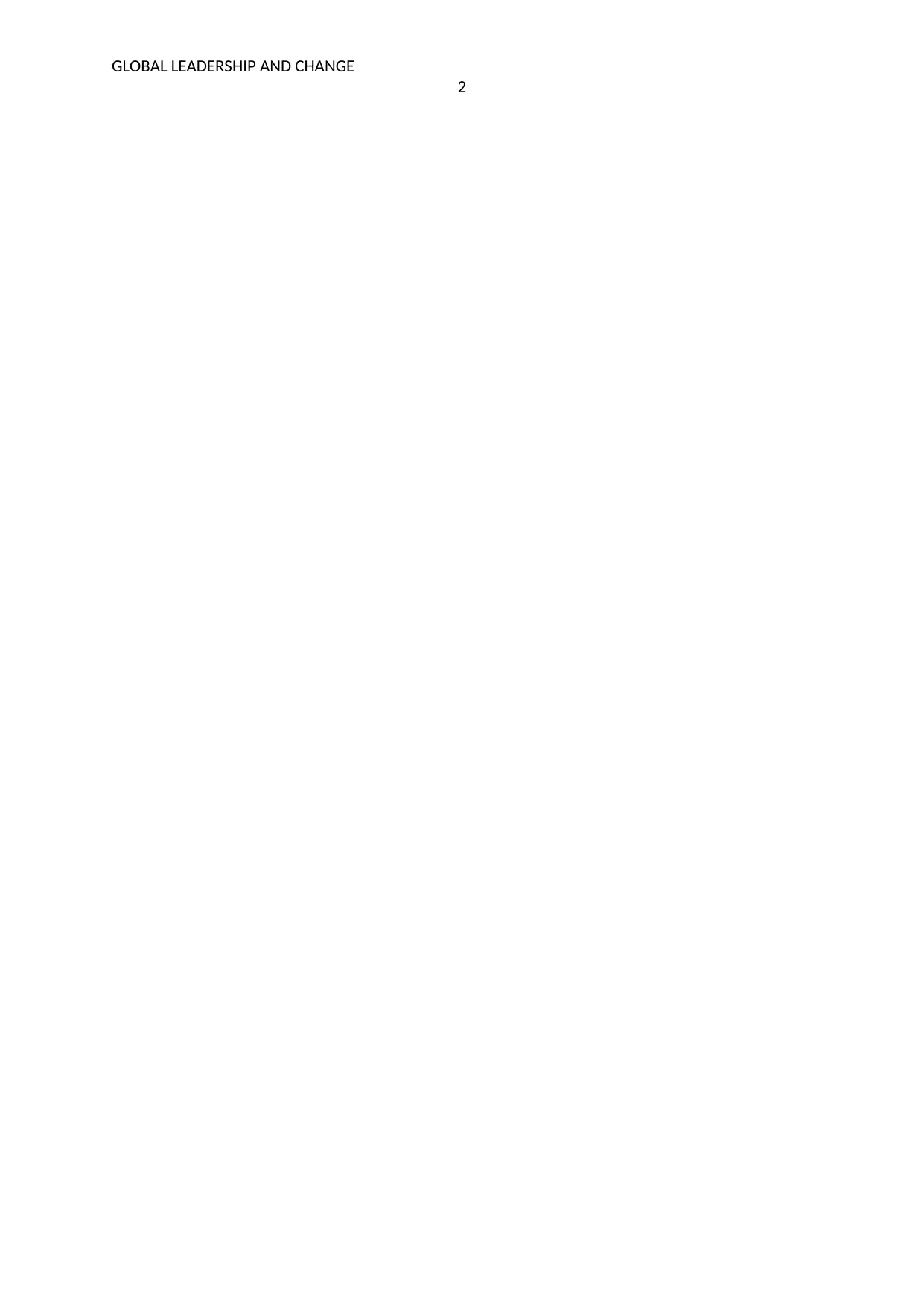
GLOBAL LEADERSHIP AND CHANGE
2
2
⊘ This is a preview!⊘
Do you want full access?
Subscribe today to unlock all pages.

Trusted by 1+ million students worldwide
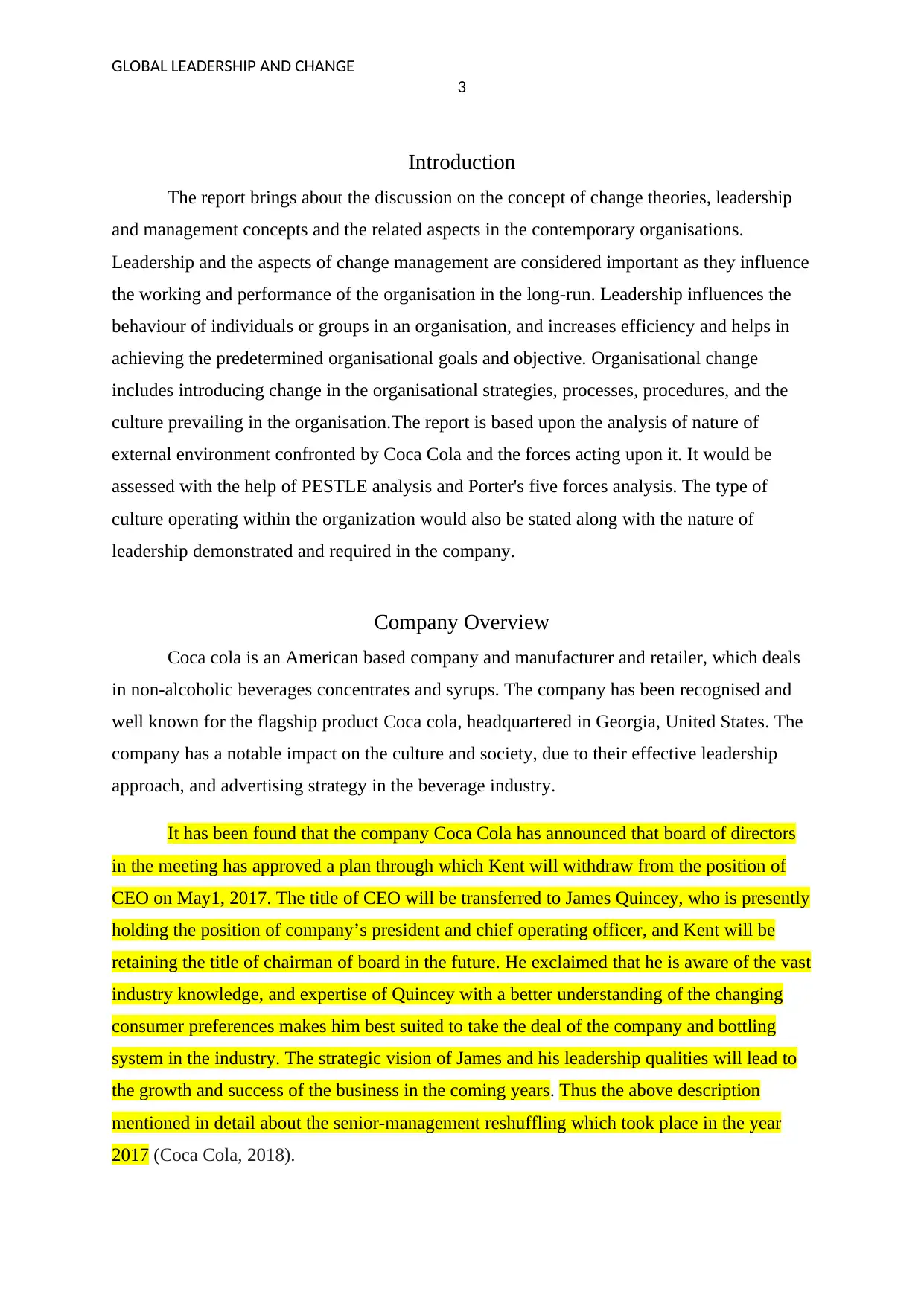
GLOBAL LEADERSHIP AND CHANGE
3
Introduction
The report brings about the discussion on the concept of change theories, leadership
and management concepts and the related aspects in the contemporary organisations.
Leadership and the aspects of change management are considered important as they influence
the working and performance of the organisation in the long-run. Leadership influences the
behaviour of individuals or groups in an organisation, and increases efficiency and helps in
achieving the predetermined organisational goals and objective. Organisational change
includes introducing change in the organisational strategies, processes, procedures, and the
culture prevailing in the organisation.The report is based upon the analysis of nature of
external environment confronted by Coca Cola and the forces acting upon it. It would be
assessed with the help of PESTLE analysis and Porter's five forces analysis. The type of
culture operating within the organization would also be stated along with the nature of
leadership demonstrated and required in the company.
Company Overview
Coca cola is an American based company and manufacturer and retailer, which deals
in non-alcoholic beverages concentrates and syrups. The company has been recognised and
well known for the flagship product Coca cola, headquartered in Georgia, United States. The
company has a notable impact on the culture and society, due to their effective leadership
approach, and advertising strategy in the beverage industry.
It has been found that the company Coca Cola has announced that board of directors
in the meeting has approved a plan through which Kent will withdraw from the position of
CEO on May1, 2017. The title of CEO will be transferred to James Quincey, who is presently
holding the position of company’s president and chief operating officer, and Kent will be
retaining the title of chairman of board in the future. He exclaimed that he is aware of the vast
industry knowledge, and expertise of Quincey with a better understanding of the changing
consumer preferences makes him best suited to take the deal of the company and bottling
system in the industry. The strategic vision of James and his leadership qualities will lead to
the growth and success of the business in the coming years. Thus the above description
mentioned in detail about the senior-management reshuffling which took place in the year
2017 (Coca Cola, 2018).
3
Introduction
The report brings about the discussion on the concept of change theories, leadership
and management concepts and the related aspects in the contemporary organisations.
Leadership and the aspects of change management are considered important as they influence
the working and performance of the organisation in the long-run. Leadership influences the
behaviour of individuals or groups in an organisation, and increases efficiency and helps in
achieving the predetermined organisational goals and objective. Organisational change
includes introducing change in the organisational strategies, processes, procedures, and the
culture prevailing in the organisation.The report is based upon the analysis of nature of
external environment confronted by Coca Cola and the forces acting upon it. It would be
assessed with the help of PESTLE analysis and Porter's five forces analysis. The type of
culture operating within the organization would also be stated along with the nature of
leadership demonstrated and required in the company.
Company Overview
Coca cola is an American based company and manufacturer and retailer, which deals
in non-alcoholic beverages concentrates and syrups. The company has been recognised and
well known for the flagship product Coca cola, headquartered in Georgia, United States. The
company has a notable impact on the culture and society, due to their effective leadership
approach, and advertising strategy in the beverage industry.
It has been found that the company Coca Cola has announced that board of directors
in the meeting has approved a plan through which Kent will withdraw from the position of
CEO on May1, 2017. The title of CEO will be transferred to James Quincey, who is presently
holding the position of company’s president and chief operating officer, and Kent will be
retaining the title of chairman of board in the future. He exclaimed that he is aware of the vast
industry knowledge, and expertise of Quincey with a better understanding of the changing
consumer preferences makes him best suited to take the deal of the company and bottling
system in the industry. The strategic vision of James and his leadership qualities will lead to
the growth and success of the business in the coming years. Thus the above description
mentioned in detail about the senior-management reshuffling which took place in the year
2017 (Coca Cola, 2018).
Paraphrase This Document
Need a fresh take? Get an instant paraphrase of this document with our AI Paraphraser
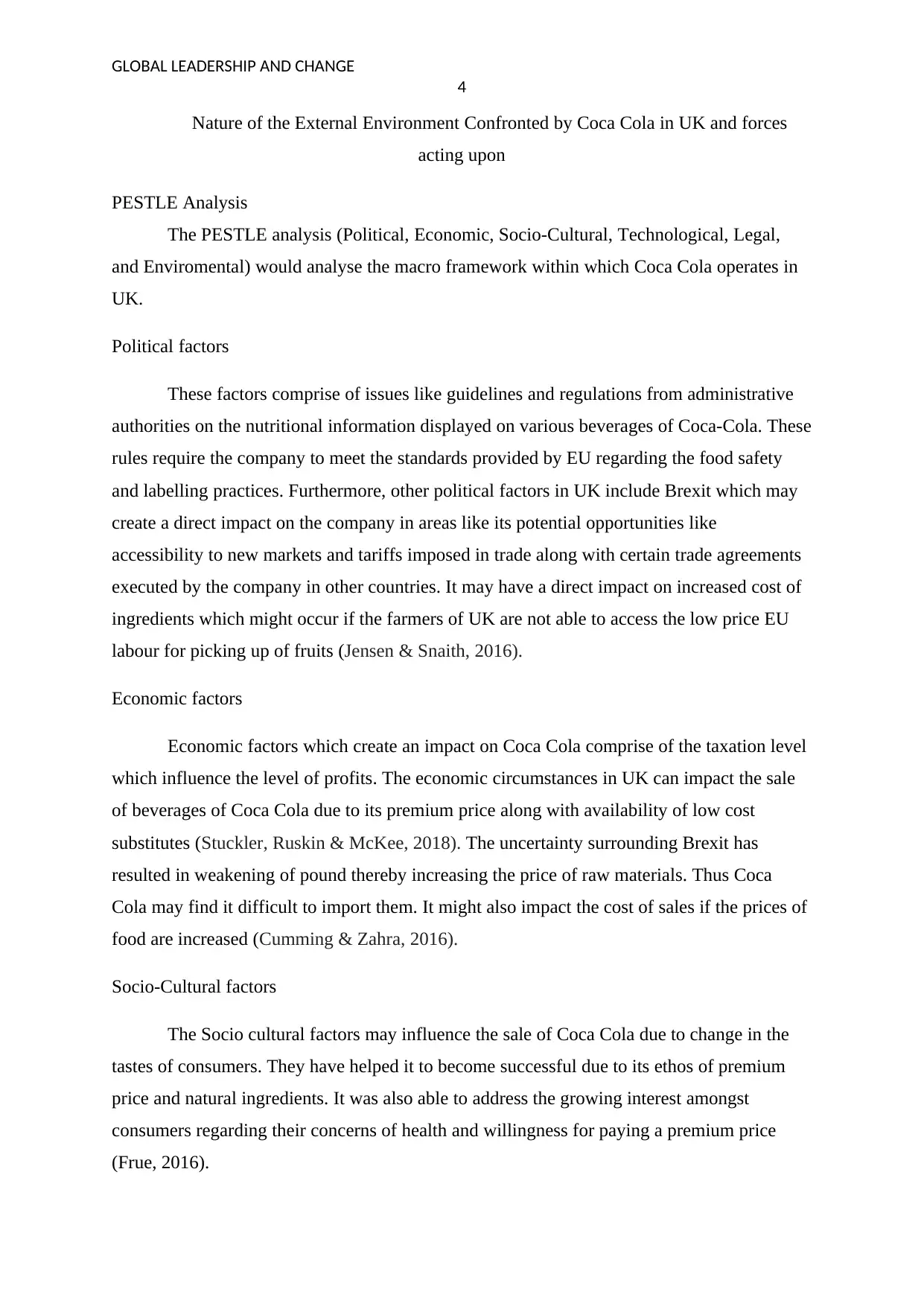
GLOBAL LEADERSHIP AND CHANGE
4
Nature of the External Environment Confronted by Coca Cola in UK and forces
acting upon
PESTLE Analysis
The PESTLE analysis (Political, Economic, Socio-Cultural, Technological, Legal,
and Enviromental) would analyse the macro framework within which Coca Cola operates in
UK.
Political factors
These factors comprise of issues like guidelines and regulations from administrative
authorities on the nutritional information displayed on various beverages of Coca-Cola. These
rules require the company to meet the standards provided by EU regarding the food safety
and labelling practices. Furthermore, other political factors in UK include Brexit which may
create a direct impact on the company in areas like its potential opportunities like
accessibility to new markets and tariffs imposed in trade along with certain trade agreements
executed by the company in other countries. It may have a direct impact on increased cost of
ingredients which might occur if the farmers of UK are not able to access the low price EU
labour for picking up of fruits (Jensen & Snaith, 2016).
Economic factors
Economic factors which create an impact on Coca Cola comprise of the taxation level
which influence the level of profits. The economic circumstances in UK can impact the sale
of beverages of Coca Cola due to its premium price along with availability of low cost
substitutes (Stuckler, Ruskin & McKee, 2018). The uncertainty surrounding Brexit has
resulted in weakening of pound thereby increasing the price of raw materials. Thus Coca
Cola may find it difficult to import them. It might also impact the cost of sales if the prices of
food are increased (Cumming & Zahra, 2016).
Socio-Cultural factors
The Socio cultural factors may influence the sale of Coca Cola due to change in the
tastes of consumers. They have helped it to become successful due to its ethos of premium
price and natural ingredients. It was also able to address the growing interest amongst
consumers regarding their concerns of health and willingness for paying a premium price
(Frue, 2016).
4
Nature of the External Environment Confronted by Coca Cola in UK and forces
acting upon
PESTLE Analysis
The PESTLE analysis (Political, Economic, Socio-Cultural, Technological, Legal,
and Enviromental) would analyse the macro framework within which Coca Cola operates in
UK.
Political factors
These factors comprise of issues like guidelines and regulations from administrative
authorities on the nutritional information displayed on various beverages of Coca-Cola. These
rules require the company to meet the standards provided by EU regarding the food safety
and labelling practices. Furthermore, other political factors in UK include Brexit which may
create a direct impact on the company in areas like its potential opportunities like
accessibility to new markets and tariffs imposed in trade along with certain trade agreements
executed by the company in other countries. It may have a direct impact on increased cost of
ingredients which might occur if the farmers of UK are not able to access the low price EU
labour for picking up of fruits (Jensen & Snaith, 2016).
Economic factors
Economic factors which create an impact on Coca Cola comprise of the taxation level
which influence the level of profits. The economic circumstances in UK can impact the sale
of beverages of Coca Cola due to its premium price along with availability of low cost
substitutes (Stuckler, Ruskin & McKee, 2018). The uncertainty surrounding Brexit has
resulted in weakening of pound thereby increasing the price of raw materials. Thus Coca
Cola may find it difficult to import them. It might also impact the cost of sales if the prices of
food are increased (Cumming & Zahra, 2016).
Socio-Cultural factors
The Socio cultural factors may influence the sale of Coca Cola due to change in the
tastes of consumers. They have helped it to become successful due to its ethos of premium
price and natural ingredients. It was also able to address the growing interest amongst
consumers regarding their concerns of health and willingness for paying a premium price
(Frue, 2016).
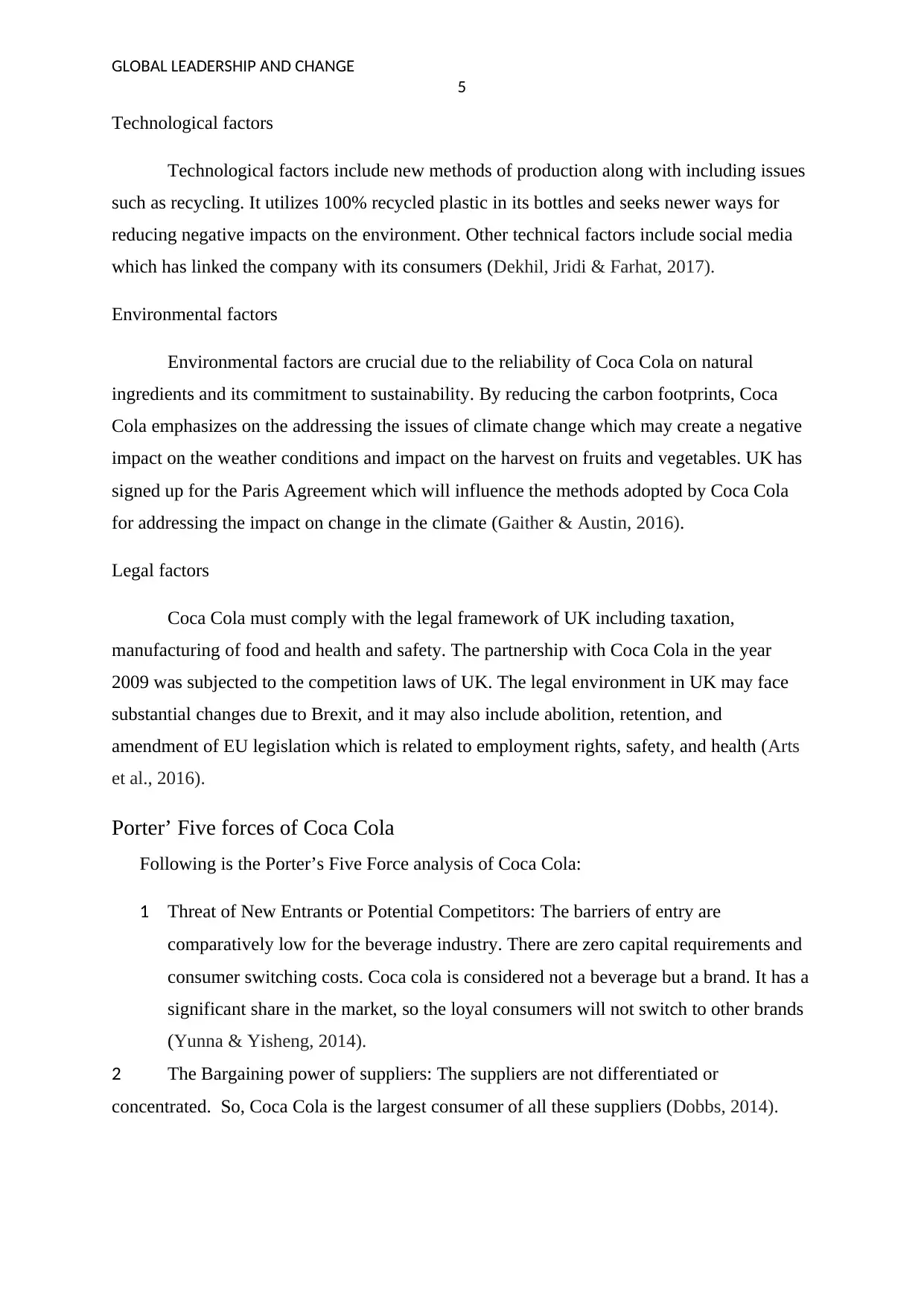
GLOBAL LEADERSHIP AND CHANGE
5
Technological factors
Technological factors include new methods of production along with including issues
such as recycling. It utilizes 100% recycled plastic in its bottles and seeks newer ways for
reducing negative impacts on the environment. Other technical factors include social media
which has linked the company with its consumers (Dekhil, Jridi & Farhat, 2017).
Environmental factors
Environmental factors are crucial due to the reliability of Coca Cola on natural
ingredients and its commitment to sustainability. By reducing the carbon footprints, Coca
Cola emphasizes on the addressing the issues of climate change which may create a negative
impact on the weather conditions and impact on the harvest on fruits and vegetables. UK has
signed up for the Paris Agreement which will influence the methods adopted by Coca Cola
for addressing the impact on change in the climate (Gaither & Austin, 2016).
Legal factors
Coca Cola must comply with the legal framework of UK including taxation,
manufacturing of food and health and safety. The partnership with Coca Cola in the year
2009 was subjected to the competition laws of UK. The legal environment in UK may face
substantial changes due to Brexit, and it may also include abolition, retention, and
amendment of EU legislation which is related to employment rights, safety, and health (Arts
et al., 2016).
Porter’ Five forces of Coca Cola
Following is the Porter’s Five Force analysis of Coca Cola:
1 Threat of New Entrants or Potential Competitors: The barriers of entry are
comparatively low for the beverage industry. There are zero capital requirements and
consumer switching costs. Coca cola is considered not a beverage but a brand. It has a
significant share in the market, so the loyal consumers will not switch to other brands
(Yunna & Yisheng, 2014).
2 The Bargaining power of suppliers: The suppliers are not differentiated or
concentrated. So, Coca Cola is the largest consumer of all these suppliers (Dobbs, 2014).
5
Technological factors
Technological factors include new methods of production along with including issues
such as recycling. It utilizes 100% recycled plastic in its bottles and seeks newer ways for
reducing negative impacts on the environment. Other technical factors include social media
which has linked the company with its consumers (Dekhil, Jridi & Farhat, 2017).
Environmental factors
Environmental factors are crucial due to the reliability of Coca Cola on natural
ingredients and its commitment to sustainability. By reducing the carbon footprints, Coca
Cola emphasizes on the addressing the issues of climate change which may create a negative
impact on the weather conditions and impact on the harvest on fruits and vegetables. UK has
signed up for the Paris Agreement which will influence the methods adopted by Coca Cola
for addressing the impact on change in the climate (Gaither & Austin, 2016).
Legal factors
Coca Cola must comply with the legal framework of UK including taxation,
manufacturing of food and health and safety. The partnership with Coca Cola in the year
2009 was subjected to the competition laws of UK. The legal environment in UK may face
substantial changes due to Brexit, and it may also include abolition, retention, and
amendment of EU legislation which is related to employment rights, safety, and health (Arts
et al., 2016).
Porter’ Five forces of Coca Cola
Following is the Porter’s Five Force analysis of Coca Cola:
1 Threat of New Entrants or Potential Competitors: The barriers of entry are
comparatively low for the beverage industry. There are zero capital requirements and
consumer switching costs. Coca cola is considered not a beverage but a brand. It has a
significant share in the market, so the loyal consumers will not switch to other brands
(Yunna & Yisheng, 2014).
2 The Bargaining power of suppliers: The suppliers are not differentiated or
concentrated. So, Coca Cola is the largest consumer of all these suppliers (Dobbs, 2014).
⊘ This is a preview!⊘
Do you want full access?
Subscribe today to unlock all pages.

Trusted by 1+ million students worldwide
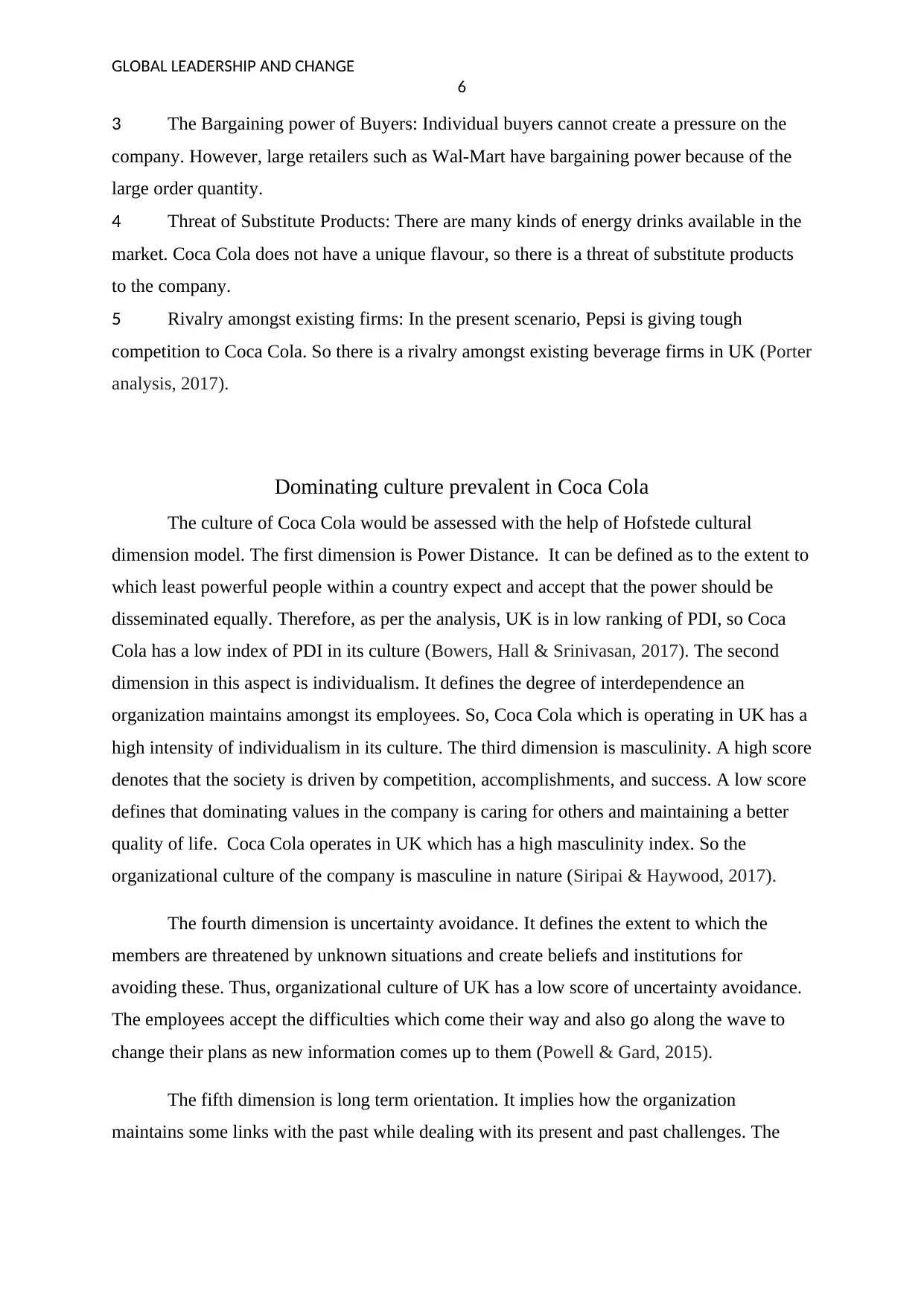
GLOBAL LEADERSHIP AND CHANGE
6
3 The Bargaining power of Buyers: Individual buyers cannot create a pressure on the
company. However, large retailers such as Wal-Mart have bargaining power because of the
large order quantity.
4 Threat of Substitute Products: There are many kinds of energy drinks available in the
market. Coca Cola does not have a unique flavour, so there is a threat of substitute products
to the company.
5 Rivalry amongst existing firms: In the present scenario, Pepsi is giving tough
competition to Coca Cola. So there is a rivalry amongst existing beverage firms in UK (Porter
analysis, 2017).
Dominating culture prevalent in Coca Cola
The culture of Coca Cola would be assessed with the help of Hofstede cultural
dimension model. The first dimension is Power Distance. It can be defined as to the extent to
which least powerful people within a country expect and accept that the power should be
disseminated equally. Therefore, as per the analysis, UK is in low ranking of PDI, so Coca
Cola has a low index of PDI in its culture (Bowers, Hall & Srinivasan, 2017). The second
dimension in this aspect is individualism. It defines the degree of interdependence an
organization maintains amongst its employees. So, Coca Cola which is operating in UK has a
high intensity of individualism in its culture. The third dimension is masculinity. A high score
denotes that the society is driven by competition, accomplishments, and success. A low score
defines that dominating values in the company is caring for others and maintaining a better
quality of life. Coca Cola operates in UK which has a high masculinity index. So the
organizational culture of the company is masculine in nature (Siripai & Haywood, 2017).
The fourth dimension is uncertainty avoidance. It defines the extent to which the
members are threatened by unknown situations and create beliefs and institutions for
avoiding these. Thus, organizational culture of UK has a low score of uncertainty avoidance.
The employees accept the difficulties which come their way and also go along the wave to
change their plans as new information comes up to them (Powell & Gard, 2015).
The fifth dimension is long term orientation. It implies how the organization
maintains some links with the past while dealing with its present and past challenges. The
6
3 The Bargaining power of Buyers: Individual buyers cannot create a pressure on the
company. However, large retailers such as Wal-Mart have bargaining power because of the
large order quantity.
4 Threat of Substitute Products: There are many kinds of energy drinks available in the
market. Coca Cola does not have a unique flavour, so there is a threat of substitute products
to the company.
5 Rivalry amongst existing firms: In the present scenario, Pepsi is giving tough
competition to Coca Cola. So there is a rivalry amongst existing beverage firms in UK (Porter
analysis, 2017).
Dominating culture prevalent in Coca Cola
The culture of Coca Cola would be assessed with the help of Hofstede cultural
dimension model. The first dimension is Power Distance. It can be defined as to the extent to
which least powerful people within a country expect and accept that the power should be
disseminated equally. Therefore, as per the analysis, UK is in low ranking of PDI, so Coca
Cola has a low index of PDI in its culture (Bowers, Hall & Srinivasan, 2017). The second
dimension in this aspect is individualism. It defines the degree of interdependence an
organization maintains amongst its employees. So, Coca Cola which is operating in UK has a
high intensity of individualism in its culture. The third dimension is masculinity. A high score
denotes that the society is driven by competition, accomplishments, and success. A low score
defines that dominating values in the company is caring for others and maintaining a better
quality of life. Coca Cola operates in UK which has a high masculinity index. So the
organizational culture of the company is masculine in nature (Siripai & Haywood, 2017).
The fourth dimension is uncertainty avoidance. It defines the extent to which the
members are threatened by unknown situations and create beliefs and institutions for
avoiding these. Thus, organizational culture of UK has a low score of uncertainty avoidance.
The employees accept the difficulties which come their way and also go along the wave to
change their plans as new information comes up to them (Powell & Gard, 2015).
The fifth dimension is long term orientation. It implies how the organization
maintains some links with the past while dealing with its present and past challenges. The
Paraphrase This Document
Need a fresh take? Get an instant paraphrase of this document with our AI Paraphraser
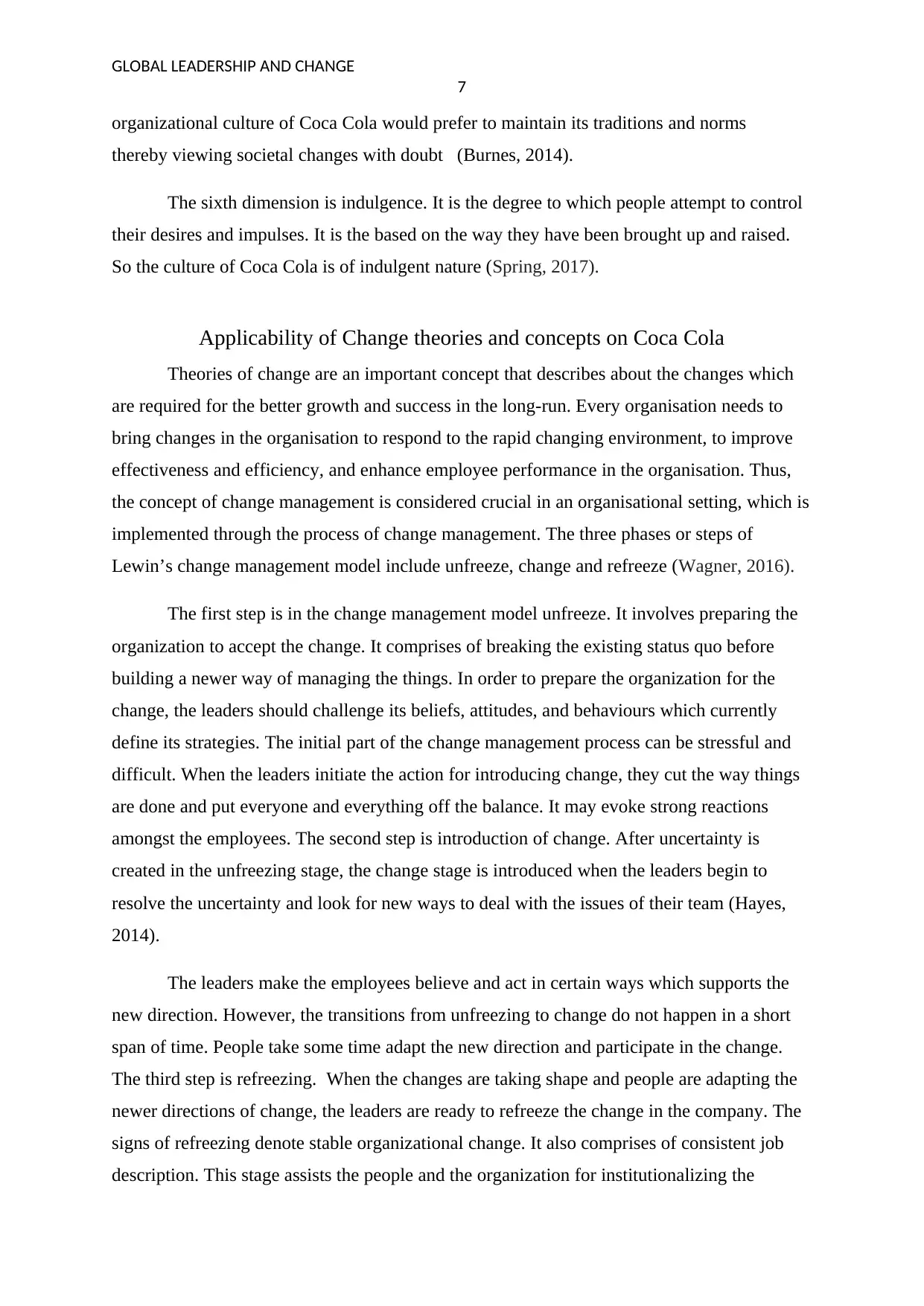
GLOBAL LEADERSHIP AND CHANGE
7
organizational culture of Coca Cola would prefer to maintain its traditions and norms
thereby viewing societal changes with doubt (Burnes, 2014).
The sixth dimension is indulgence. It is the degree to which people attempt to control
their desires and impulses. It is the based on the way they have been brought up and raised.
So the culture of Coca Cola is of indulgent nature (Spring, 2017).
Applicability of Change theories and concepts on Coca Cola
Theories of change are an important concept that describes about the changes which
are required for the better growth and success in the long-run. Every organisation needs to
bring changes in the organisation to respond to the rapid changing environment, to improve
effectiveness and efficiency, and enhance employee performance in the organisation. Thus,
the concept of change management is considered crucial in an organisational setting, which is
implemented through the process of change management. The three phases or steps of
Lewin’s change management model include unfreeze, change and refreeze (Wagner, 2016).
The first step is in the change management model unfreeze. It involves preparing the
organization to accept the change. It comprises of breaking the existing status quo before
building a newer way of managing the things. In order to prepare the organization for the
change, the leaders should challenge its beliefs, attitudes, and behaviours which currently
define its strategies. The initial part of the change management process can be stressful and
difficult. When the leaders initiate the action for introducing change, they cut the way things
are done and put everyone and everything off the balance. It may evoke strong reactions
amongst the employees. The second step is introduction of change. After uncertainty is
created in the unfreezing stage, the change stage is introduced when the leaders begin to
resolve the uncertainty and look for new ways to deal with the issues of their team (Hayes,
2014).
The leaders make the employees believe and act in certain ways which supports the
new direction. However, the transitions from unfreezing to change do not happen in a short
span of time. People take some time adapt the new direction and participate in the change.
The third step is refreezing. When the changes are taking shape and people are adapting the
newer directions of change, the leaders are ready to refreeze the change in the company. The
signs of refreezing denote stable organizational change. It also comprises of consistent job
description. This stage assists the people and the organization for institutionalizing the
7
organizational culture of Coca Cola would prefer to maintain its traditions and norms
thereby viewing societal changes with doubt (Burnes, 2014).
The sixth dimension is indulgence. It is the degree to which people attempt to control
their desires and impulses. It is the based on the way they have been brought up and raised.
So the culture of Coca Cola is of indulgent nature (Spring, 2017).
Applicability of Change theories and concepts on Coca Cola
Theories of change are an important concept that describes about the changes which
are required for the better growth and success in the long-run. Every organisation needs to
bring changes in the organisation to respond to the rapid changing environment, to improve
effectiveness and efficiency, and enhance employee performance in the organisation. Thus,
the concept of change management is considered crucial in an organisational setting, which is
implemented through the process of change management. The three phases or steps of
Lewin’s change management model include unfreeze, change and refreeze (Wagner, 2016).
The first step is in the change management model unfreeze. It involves preparing the
organization to accept the change. It comprises of breaking the existing status quo before
building a newer way of managing the things. In order to prepare the organization for the
change, the leaders should challenge its beliefs, attitudes, and behaviours which currently
define its strategies. The initial part of the change management process can be stressful and
difficult. When the leaders initiate the action for introducing change, they cut the way things
are done and put everyone and everything off the balance. It may evoke strong reactions
amongst the employees. The second step is introduction of change. After uncertainty is
created in the unfreezing stage, the change stage is introduced when the leaders begin to
resolve the uncertainty and look for new ways to deal with the issues of their team (Hayes,
2014).
The leaders make the employees believe and act in certain ways which supports the
new direction. However, the transitions from unfreezing to change do not happen in a short
span of time. People take some time adapt the new direction and participate in the change.
The third step is refreezing. When the changes are taking shape and people are adapting the
newer directions of change, the leaders are ready to refreeze the change in the company. The
signs of refreezing denote stable organizational change. It also comprises of consistent job
description. This stage assists the people and the organization for institutionalizing the
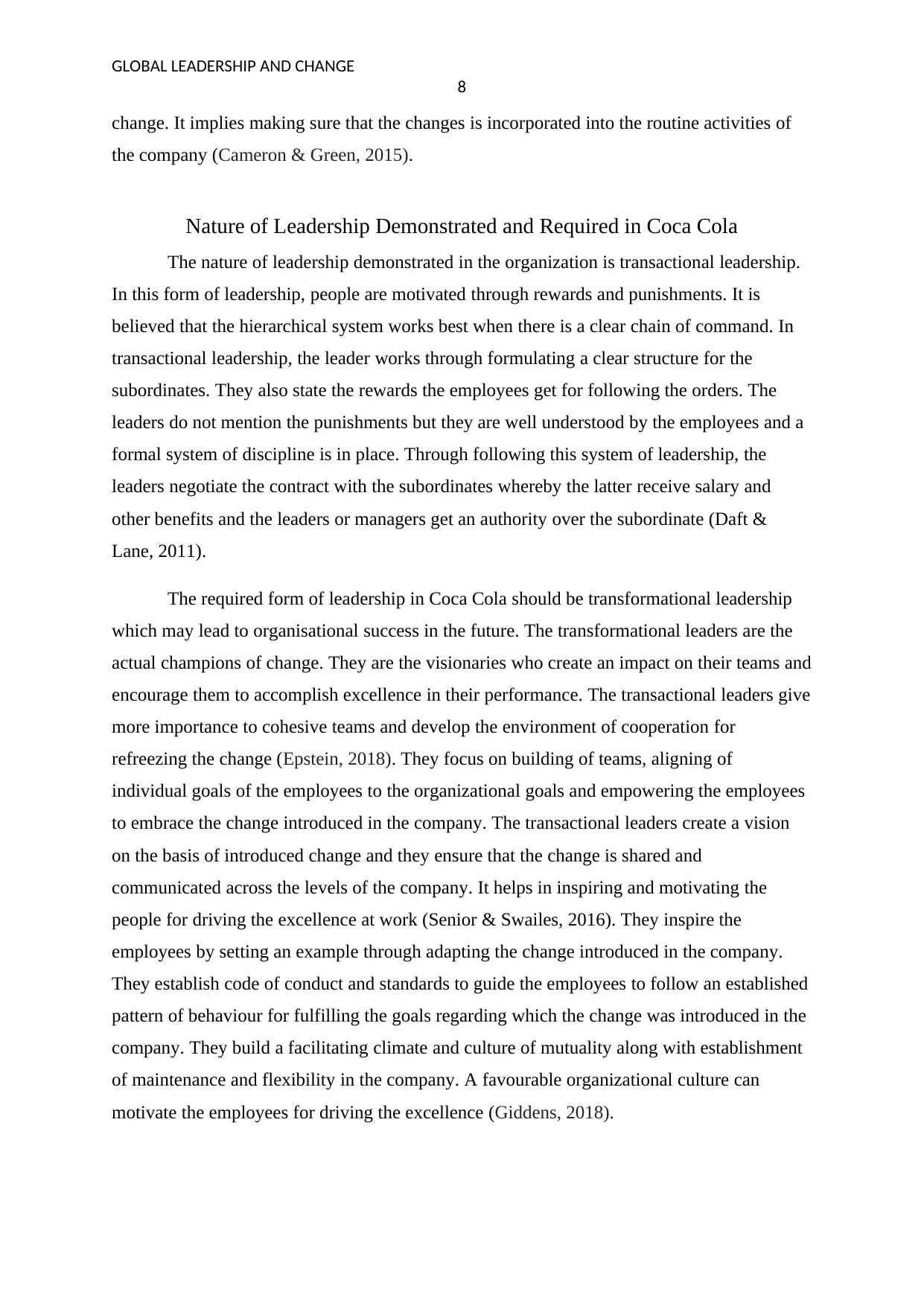
GLOBAL LEADERSHIP AND CHANGE
8
change. It implies making sure that the changes is incorporated into the routine activities of
the company (Cameron & Green, 2015).
Nature of Leadership Demonstrated and Required in Coca Cola
The nature of leadership demonstrated in the organization is transactional leadership.
In this form of leadership, people are motivated through rewards and punishments. It is
believed that the hierarchical system works best when there is a clear chain of command. In
transactional leadership, the leader works through formulating a clear structure for the
subordinates. They also state the rewards the employees get for following the orders. The
leaders do not mention the punishments but they are well understood by the employees and a
formal system of discipline is in place. Through following this system of leadership, the
leaders negotiate the contract with the subordinates whereby the latter receive salary and
other benefits and the leaders or managers get an authority over the subordinate (Daft &
Lane, 2011).
The required form of leadership in Coca Cola should be transformational leadership
which may lead to organisational success in the future. The transformational leaders are the
actual champions of change. They are the visionaries who create an impact on their teams and
encourage them to accomplish excellence in their performance. The transactional leaders give
more importance to cohesive teams and develop the environment of cooperation for
refreezing the change (Epstein, 2018). They focus on building of teams, aligning of
individual goals of the employees to the organizational goals and empowering the employees
to embrace the change introduced in the company. The transactional leaders create a vision
on the basis of introduced change and they ensure that the change is shared and
communicated across the levels of the company. It helps in inspiring and motivating the
people for driving the excellence at work (Senior & Swailes, 2016). They inspire the
employees by setting an example through adapting the change introduced in the company.
They establish code of conduct and standards to guide the employees to follow an established
pattern of behaviour for fulfilling the goals regarding which the change was introduced in the
company. They build a facilitating climate and culture of mutuality along with establishment
of maintenance and flexibility in the company. A favourable organizational culture can
motivate the employees for driving the excellence (Giddens, 2018).
8
change. It implies making sure that the changes is incorporated into the routine activities of
the company (Cameron & Green, 2015).
Nature of Leadership Demonstrated and Required in Coca Cola
The nature of leadership demonstrated in the organization is transactional leadership.
In this form of leadership, people are motivated through rewards and punishments. It is
believed that the hierarchical system works best when there is a clear chain of command. In
transactional leadership, the leader works through formulating a clear structure for the
subordinates. They also state the rewards the employees get for following the orders. The
leaders do not mention the punishments but they are well understood by the employees and a
formal system of discipline is in place. Through following this system of leadership, the
leaders negotiate the contract with the subordinates whereby the latter receive salary and
other benefits and the leaders or managers get an authority over the subordinate (Daft &
Lane, 2011).
The required form of leadership in Coca Cola should be transformational leadership
which may lead to organisational success in the future. The transformational leaders are the
actual champions of change. They are the visionaries who create an impact on their teams and
encourage them to accomplish excellence in their performance. The transactional leaders give
more importance to cohesive teams and develop the environment of cooperation for
refreezing the change (Epstein, 2018). They focus on building of teams, aligning of
individual goals of the employees to the organizational goals and empowering the employees
to embrace the change introduced in the company. The transactional leaders create a vision
on the basis of introduced change and they ensure that the change is shared and
communicated across the levels of the company. It helps in inspiring and motivating the
people for driving the excellence at work (Senior & Swailes, 2016). They inspire the
employees by setting an example through adapting the change introduced in the company.
They establish code of conduct and standards to guide the employees to follow an established
pattern of behaviour for fulfilling the goals regarding which the change was introduced in the
company. They build a facilitating climate and culture of mutuality along with establishment
of maintenance and flexibility in the company. A favourable organizational culture can
motivate the employees for driving the excellence (Giddens, 2018).
⊘ This is a preview!⊘
Do you want full access?
Subscribe today to unlock all pages.

Trusted by 1+ million students worldwide
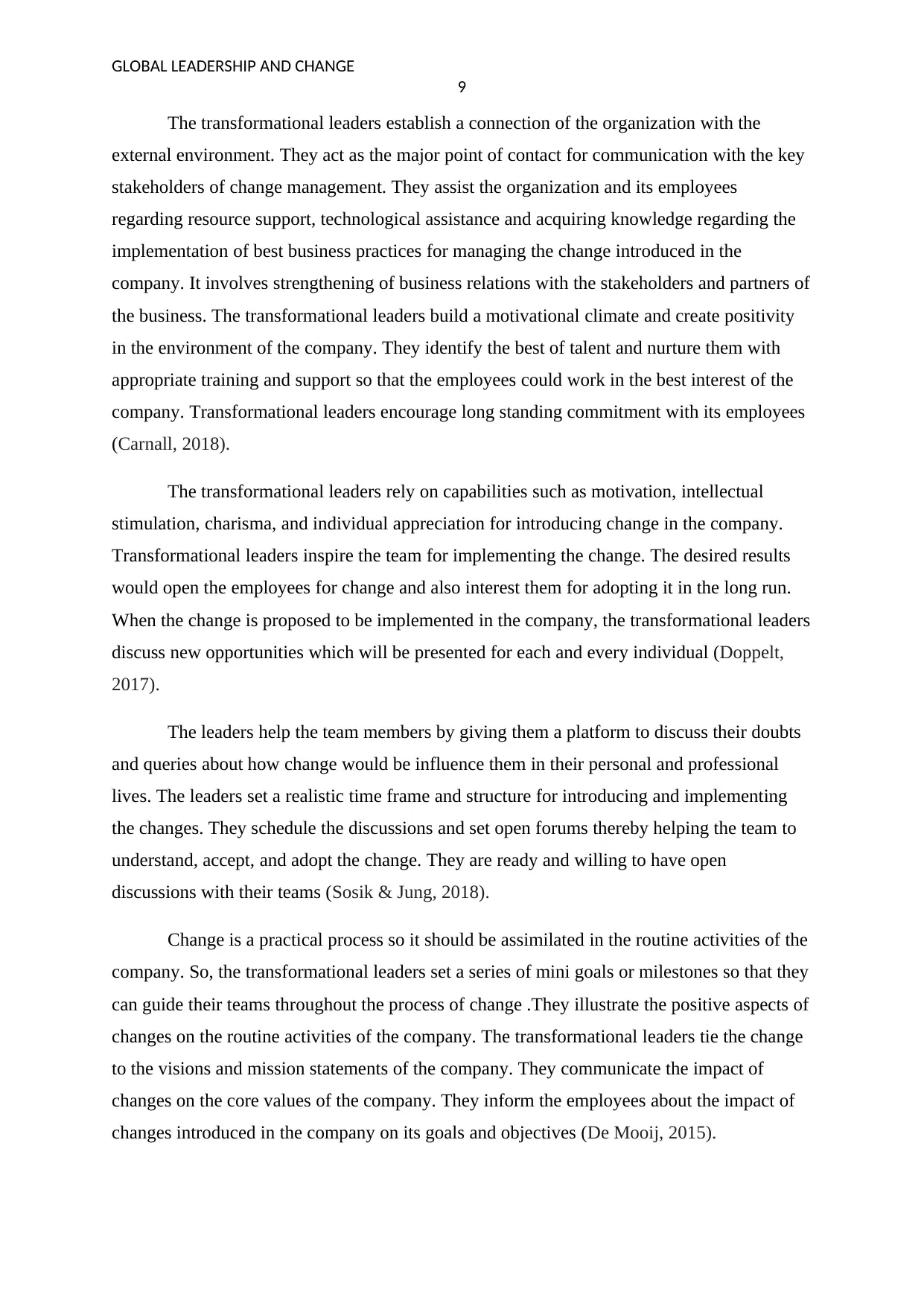
GLOBAL LEADERSHIP AND CHANGE
9
The transformational leaders establish a connection of the organization with the
external environment. They act as the major point of contact for communication with the key
stakeholders of change management. They assist the organization and its employees
regarding resource support, technological assistance and acquiring knowledge regarding the
implementation of best business practices for managing the change introduced in the
company. It involves strengthening of business relations with the stakeholders and partners of
the business. The transformational leaders build a motivational climate and create positivity
in the environment of the company. They identify the best of talent and nurture them with
appropriate training and support so that the employees could work in the best interest of the
company. Transformational leaders encourage long standing commitment with its employees
(Carnall, 2018).
The transformational leaders rely on capabilities such as motivation, intellectual
stimulation, charisma, and individual appreciation for introducing change in the company.
Transformational leaders inspire the team for implementing the change. The desired results
would open the employees for change and also interest them for adopting it in the long run.
When the change is proposed to be implemented in the company, the transformational leaders
discuss new opportunities which will be presented for each and every individual (Doppelt,
2017).
The leaders help the team members by giving them a platform to discuss their doubts
and queries about how change would be influence them in their personal and professional
lives. The leaders set a realistic time frame and structure for introducing and implementing
the changes. They schedule the discussions and set open forums thereby helping the team to
understand, accept, and adopt the change. They are ready and willing to have open
discussions with their teams (Sosik & Jung, 2018).
Change is a practical process so it should be assimilated in the routine activities of the
company. So, the transformational leaders set a series of mini goals or milestones so that they
can guide their teams throughout the process of change .They illustrate the positive aspects of
changes on the routine activities of the company. The transformational leaders tie the change
to the visions and mission statements of the company. They communicate the impact of
changes on the core values of the company. They inform the employees about the impact of
changes introduced in the company on its goals and objectives (De Mooij, 2015).
9
The transformational leaders establish a connection of the organization with the
external environment. They act as the major point of contact for communication with the key
stakeholders of change management. They assist the organization and its employees
regarding resource support, technological assistance and acquiring knowledge regarding the
implementation of best business practices for managing the change introduced in the
company. It involves strengthening of business relations with the stakeholders and partners of
the business. The transformational leaders build a motivational climate and create positivity
in the environment of the company. They identify the best of talent and nurture them with
appropriate training and support so that the employees could work in the best interest of the
company. Transformational leaders encourage long standing commitment with its employees
(Carnall, 2018).
The transformational leaders rely on capabilities such as motivation, intellectual
stimulation, charisma, and individual appreciation for introducing change in the company.
Transformational leaders inspire the team for implementing the change. The desired results
would open the employees for change and also interest them for adopting it in the long run.
When the change is proposed to be implemented in the company, the transformational leaders
discuss new opportunities which will be presented for each and every individual (Doppelt,
2017).
The leaders help the team members by giving them a platform to discuss their doubts
and queries about how change would be influence them in their personal and professional
lives. The leaders set a realistic time frame and structure for introducing and implementing
the changes. They schedule the discussions and set open forums thereby helping the team to
understand, accept, and adopt the change. They are ready and willing to have open
discussions with their teams (Sosik & Jung, 2018).
Change is a practical process so it should be assimilated in the routine activities of the
company. So, the transformational leaders set a series of mini goals or milestones so that they
can guide their teams throughout the process of change .They illustrate the positive aspects of
changes on the routine activities of the company. The transformational leaders tie the change
to the visions and mission statements of the company. They communicate the impact of
changes on the core values of the company. They inform the employees about the impact of
changes introduced in the company on its goals and objectives (De Mooij, 2015).
Paraphrase This Document
Need a fresh take? Get an instant paraphrase of this document with our AI Paraphraser
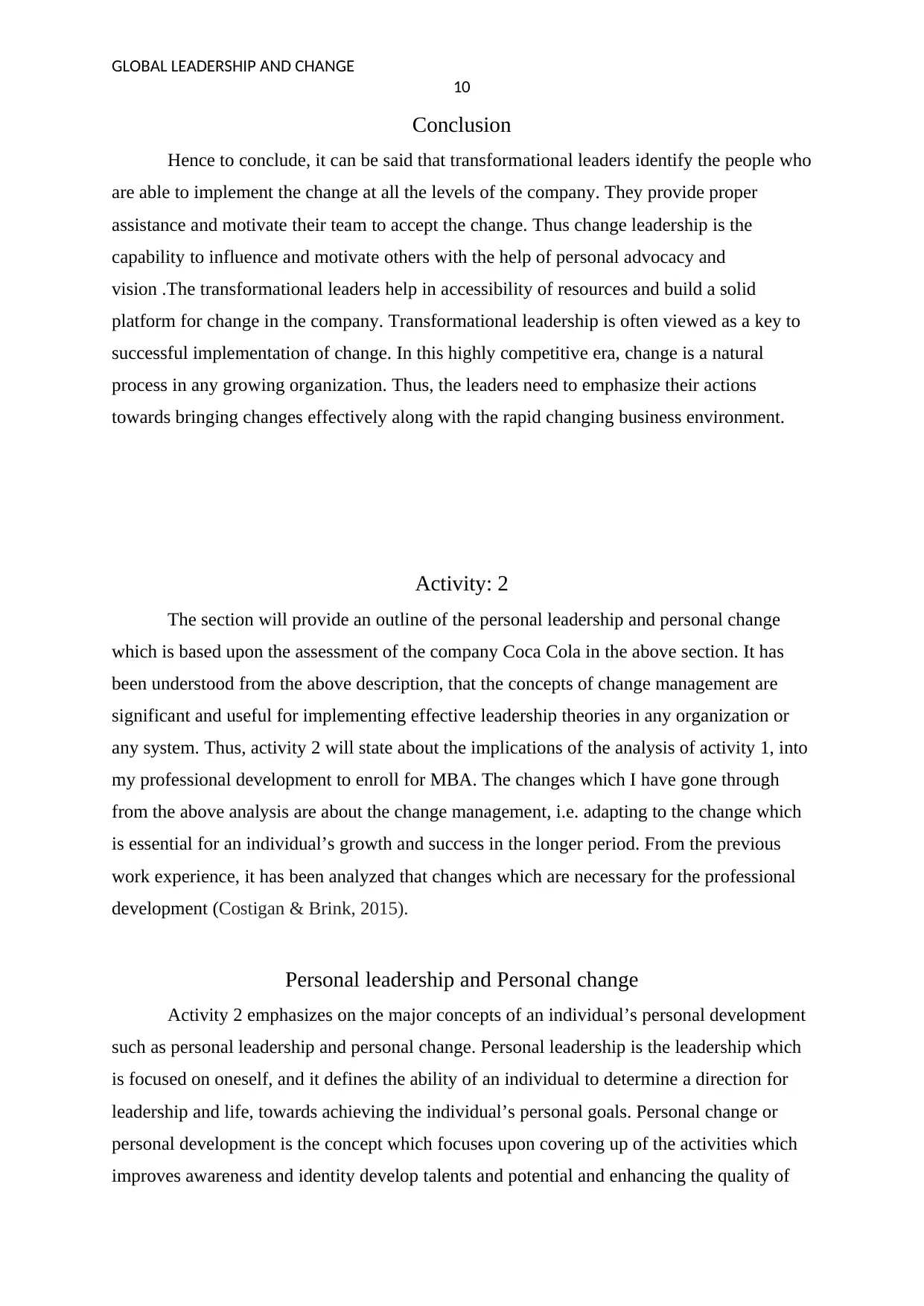
GLOBAL LEADERSHIP AND CHANGE
10
Conclusion
Hence to conclude, it can be said that transformational leaders identify the people who
are able to implement the change at all the levels of the company. They provide proper
assistance and motivate their team to accept the change. Thus change leadership is the
capability to influence and motivate others with the help of personal advocacy and
vision .The transformational leaders help in accessibility of resources and build a solid
platform for change in the company. Transformational leadership is often viewed as a key to
successful implementation of change. In this highly competitive era, change is a natural
process in any growing organization. Thus, the leaders need to emphasize their actions
towards bringing changes effectively along with the rapid changing business environment.
Activity: 2
The section will provide an outline of the personal leadership and personal change
which is based upon the assessment of the company Coca Cola in the above section. It has
been understood from the above description, that the concepts of change management are
significant and useful for implementing effective leadership theories in any organization or
any system. Thus, activity 2 will state about the implications of the analysis of activity 1, into
my professional development to enroll for MBA. The changes which I have gone through
from the above analysis are about the change management, i.e. adapting to the change which
is essential for an individual’s growth and success in the longer period. From the previous
work experience, it has been analyzed that changes which are necessary for the professional
development (Costigan & Brink, 2015).
Personal leadership and Personal change
Activity 2 emphasizes on the major concepts of an individual’s personal development
such as personal leadership and personal change. Personal leadership is the leadership which
is focused on oneself, and it defines the ability of an individual to determine a direction for
leadership and life, towards achieving the individual’s personal goals. Personal change or
personal development is the concept which focuses upon covering up of the activities which
improves awareness and identity develop talents and potential and enhancing the quality of
10
Conclusion
Hence to conclude, it can be said that transformational leaders identify the people who
are able to implement the change at all the levels of the company. They provide proper
assistance and motivate their team to accept the change. Thus change leadership is the
capability to influence and motivate others with the help of personal advocacy and
vision .The transformational leaders help in accessibility of resources and build a solid
platform for change in the company. Transformational leadership is often viewed as a key to
successful implementation of change. In this highly competitive era, change is a natural
process in any growing organization. Thus, the leaders need to emphasize their actions
towards bringing changes effectively along with the rapid changing business environment.
Activity: 2
The section will provide an outline of the personal leadership and personal change
which is based upon the assessment of the company Coca Cola in the above section. It has
been understood from the above description, that the concepts of change management are
significant and useful for implementing effective leadership theories in any organization or
any system. Thus, activity 2 will state about the implications of the analysis of activity 1, into
my professional development to enroll for MBA. The changes which I have gone through
from the above analysis are about the change management, i.e. adapting to the change which
is essential for an individual’s growth and success in the longer period. From the previous
work experience, it has been analyzed that changes which are necessary for the professional
development (Costigan & Brink, 2015).
Personal leadership and Personal change
Activity 2 emphasizes on the major concepts of an individual’s personal development
such as personal leadership and personal change. Personal leadership is the leadership which
is focused on oneself, and it defines the ability of an individual to determine a direction for
leadership and life, towards achieving the individual’s personal goals. Personal change or
personal development is the concept which focuses upon covering up of the activities which
improves awareness and identity develop talents and potential and enhancing the quality of
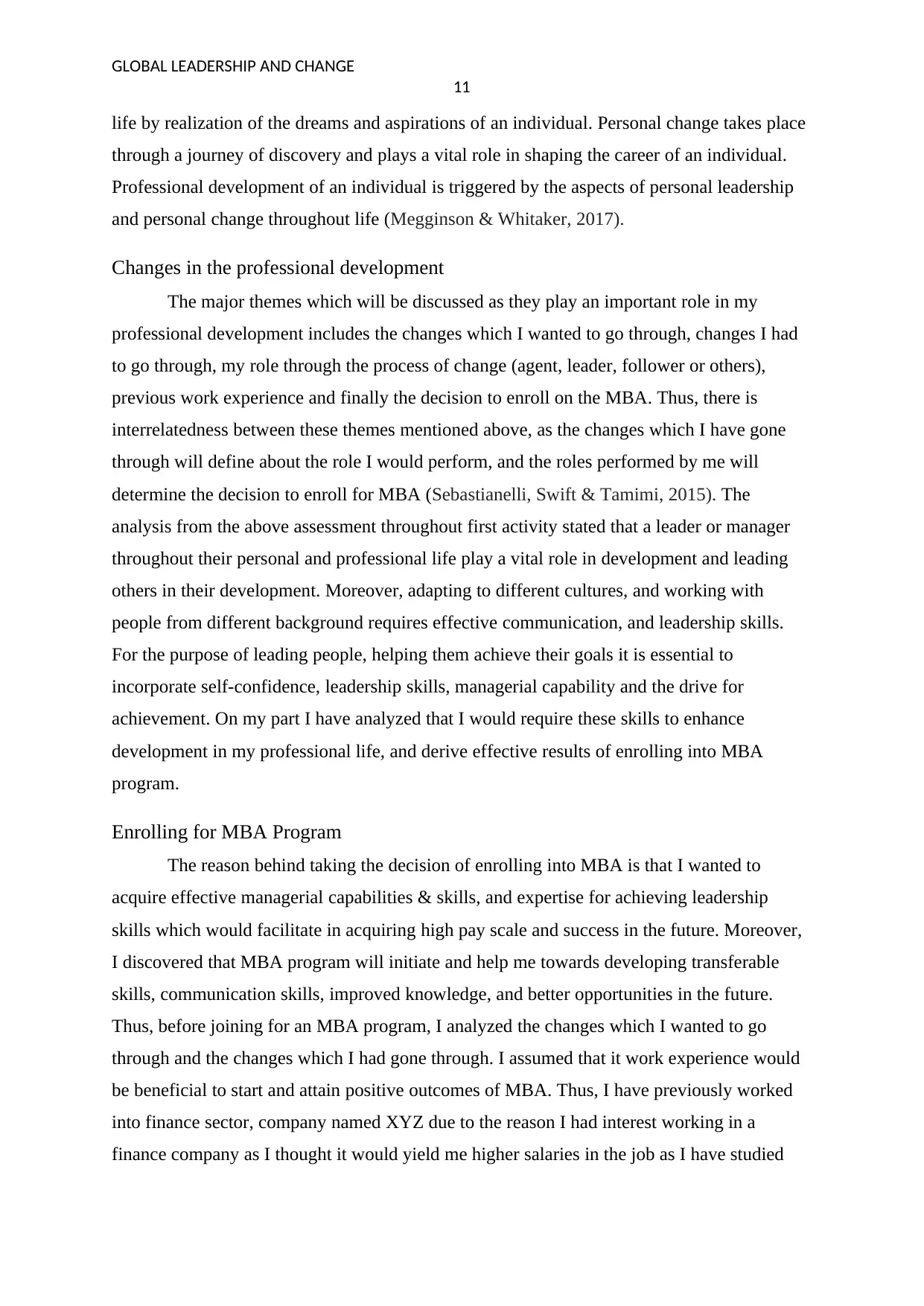
GLOBAL LEADERSHIP AND CHANGE
11
life by realization of the dreams and aspirations of an individual. Personal change takes place
through a journey of discovery and plays a vital role in shaping the career of an individual.
Professional development of an individual is triggered by the aspects of personal leadership
and personal change throughout life (Megginson & Whitaker, 2017).
Changes in the professional development
The major themes which will be discussed as they play an important role in my
professional development includes the changes which I wanted to go through, changes I had
to go through, my role through the process of change (agent, leader, follower or others),
previous work experience and finally the decision to enroll on the MBA. Thus, there is
interrelatedness between these themes mentioned above, as the changes which I have gone
through will define about the role I would perform, and the roles performed by me will
determine the decision to enroll for MBA (Sebastianelli, Swift & Tamimi, 2015). The
analysis from the above assessment throughout first activity stated that a leader or manager
throughout their personal and professional life play a vital role in development and leading
others in their development. Moreover, adapting to different cultures, and working with
people from different background requires effective communication, and leadership skills.
For the purpose of leading people, helping them achieve their goals it is essential to
incorporate self-confidence, leadership skills, managerial capability and the drive for
achievement. On my part I have analyzed that I would require these skills to enhance
development in my professional life, and derive effective results of enrolling into MBA
program.
Enrolling for MBA Program
The reason behind taking the decision of enrolling into MBA is that I wanted to
acquire effective managerial capabilities & skills, and expertise for achieving leadership
skills which would facilitate in acquiring high pay scale and success in the future. Moreover,
I discovered that MBA program will initiate and help me towards developing transferable
skills, communication skills, improved knowledge, and better opportunities in the future.
Thus, before joining for an MBA program, I analyzed the changes which I wanted to go
through and the changes which I had gone through. I assumed that it work experience would
be beneficial to start and attain positive outcomes of MBA. Thus, I have previously worked
into finance sector, company named XYZ due to the reason I had interest working in a
finance company as I thought it would yield me higher salaries in the job as I have studied
11
life by realization of the dreams and aspirations of an individual. Personal change takes place
through a journey of discovery and plays a vital role in shaping the career of an individual.
Professional development of an individual is triggered by the aspects of personal leadership
and personal change throughout life (Megginson & Whitaker, 2017).
Changes in the professional development
The major themes which will be discussed as they play an important role in my
professional development includes the changes which I wanted to go through, changes I had
to go through, my role through the process of change (agent, leader, follower or others),
previous work experience and finally the decision to enroll on the MBA. Thus, there is
interrelatedness between these themes mentioned above, as the changes which I have gone
through will define about the role I would perform, and the roles performed by me will
determine the decision to enroll for MBA (Sebastianelli, Swift & Tamimi, 2015). The
analysis from the above assessment throughout first activity stated that a leader or manager
throughout their personal and professional life play a vital role in development and leading
others in their development. Moreover, adapting to different cultures, and working with
people from different background requires effective communication, and leadership skills.
For the purpose of leading people, helping them achieve their goals it is essential to
incorporate self-confidence, leadership skills, managerial capability and the drive for
achievement. On my part I have analyzed that I would require these skills to enhance
development in my professional life, and derive effective results of enrolling into MBA
program.
Enrolling for MBA Program
The reason behind taking the decision of enrolling into MBA is that I wanted to
acquire effective managerial capabilities & skills, and expertise for achieving leadership
skills which would facilitate in acquiring high pay scale and success in the future. Moreover,
I discovered that MBA program will initiate and help me towards developing transferable
skills, communication skills, improved knowledge, and better opportunities in the future.
Thus, before joining for an MBA program, I analyzed the changes which I wanted to go
through and the changes which I had gone through. I assumed that it work experience would
be beneficial to start and attain positive outcomes of MBA. Thus, I have previously worked
into finance sector, company named XYZ due to the reason I had interest working in a
finance company as I thought it would yield me higher salaries in the job as I have studied
⊘ This is a preview!⊘
Do you want full access?
Subscribe today to unlock all pages.

Trusted by 1+ million students worldwide
1 out of 18
Related Documents
Your All-in-One AI-Powered Toolkit for Academic Success.
+13062052269
info@desklib.com
Available 24*7 on WhatsApp / Email
![[object Object]](/_next/static/media/star-bottom.7253800d.svg)
Unlock your academic potential
Copyright © 2020–2025 A2Z Services. All Rights Reserved. Developed and managed by ZUCOL.





